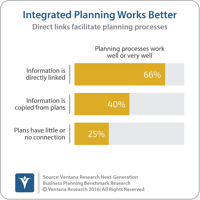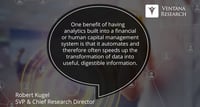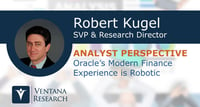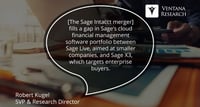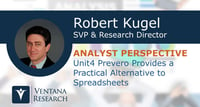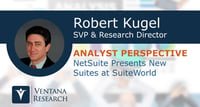Vertical strategies for enterprise resource planning systems are not new. They emerged more than two decades ago as vendors looked for ways to reduce costs and shorten time-to-value in a software category that was notorious for high costs and extended timelines. A vertical-plus strategy – the plus means it’s a platform, not just an application – takes advantage of recently available technology to extend the ease of implementation and maintenance of the system by having deeper integration with...
Read More
Topics:
Office of Finance,
Cloud Computing,
ERP and Continuous Accounting,
digital finance,
AI & Machine Learning
FinancialForce offers cloud-based ERP and professional services automation (PSA) software. The company targets midsize and larger services companies, especially those that provide professional services (such as consultants or field service organizations), subscription-based or recurring revenue services. FinancialForce’s key point of differentiation is that it is built natively on the Salesforce platform. Thus, CRM data is already located on the same platform as accounting and back-office data...
Read More
Topics:
Sales,
Office of Finance,
Recurring Revenue,
Cloud Computing,
Financial Performance Management,
ERP and Continuous Accounting,
Billing and Recurring Revenue,
revenue recognition
Workday will acquire Adaptive Insights for $1.55 billion in cash, with the transaction scheduled to close in the third quarter of this year. The combination adds Adaptive Insight’s well-developed cloud-based financial performance management software to Workday’s workforce and financial management suite. Workday says Adaptive will operate as a standalone business and continue with its current product strategy.
Read More
Topics:
Office of Finance,
Continuous Planning,
Cloud Computing,
Collaboration,
Financial Performance Management
Blockchains are attractive because their built-in security and trust factors make them useful for almost all business interactions involving organizations and individuals. Blockchains have two basic functions. One is as a method for handling transactions involving property such as land deeds, trademarks or other assets. The second involves exchanges of data such as identities of individuals or businesses, the location of an object at a point in time or weather conditions. All interactions...
Read More
Topics:
Big Data,
Data Science,
Mobile,
Marketing Performance Management,
Office of Finance,
Analytics,
Business Intelligence,
Cloud Computing,
Data Governance,
Data Integration,
Data Preparation,
Internet of Things,
Digital Technology,
Digital Marketing,
Digital Commerce,
Operations & Supply Chain
Workday recently presented a technology summit for industry analysts. The presentations focused on Workday’s ongoing product advancements as well as its approach to employing emerging technologies. These technologies include artificial intelligence (AI) and machine learning (ML), robotic process automation (RPA) and bots utilizing natural language processing. Ventana Research uses the term “robotic finance” to refer to these technologies when used in the office of finance. In our view, they...
Read More
Topics:
Big Data,
Data Science,
Mobile,
Machine Learning,
Office of Finance,
Continuous Planning,
Cloud Computing,
Collaboration,
Financial Performance Management,
ERP and Continuous Accounting
After more than a decade of steady development, ERP systems today are changing fundamentally, facilitated by the availability of advances such as cloud computing, advanced database architecture, collaboration, improved user-interface design, mobility, analytics and planning. This was evident when Oracle recently held its third analysts-only ERP Cloud Summit in New York to coincide with its Modern Finance Experience event. Oracle now has an increasingly robust set of business applications that...
Read More
Topics:
Mobile,
ERP,
Machine Learning,
Cloud Computing,
Robotic Process Automation,
Artificial intelligence,
blockchain,
AI
Oracle OpenWorld is a fall event that sprawls over a lot of territory – figuratively in terms of the IT landscape and, if you’re in San Francisco, literally. My focus here is on the ERP portion of the company’s software portfolio.
Read More
Topics:
Office of Finance,
Recurring Revenue,
Cloud Computing,
asc 606,
Enterprise Resource Planning,
ERP and Continuous Accounting,
revenue recognition
Sage Intacct recently held its annual user group meeting. The cloud financial management software service provider targets rapidly growing small- and midsize services companies. Within this broad category, Sage Intacct focuses on verticals including software, financial services, healthcare, nonprofits, wholesale and franchisers.
Read More
Topics:
Office of Finance,
Recurring Revenue,
Cloud Computing,
asc 606,
Enterprise Resource Planning,
ERP and Continuous Accounting,
revenue recognition
In 2016 Unit4acquired Prevero, a financial performance management software company. The acquisition reflects a trend toward theconvergence of transactional and analytical business applications. ERP and financial management software vendors increasingly are adding analytic capabilities – especially in financial performance management (FPM) – to the core functions of transaction processing and accounting in order to broaden the scope of their offerings. The integration of transaction processing...
Read More
Topics:
Marketing,
Office of Finance,
Continuous Planning,
Analytics,
Business Intelligence,
Cloud Computing,
Collaboration,
Workforce Management,
Financial Performance Management,
FPM,
Work and Resource Management,
Operations & Supply Chain,
Sales Planning and Analytics
I recently attended SuiteWorld, NetSuite’s annual user conference. In the opening keynotes and throughout the event speakers emphasized benefits for NetSuite users resulting from the merger of NetSuite and Oracle, completed last fall. I wrote about this at the time. NetSuite users are likely to benefit from Oracle’s sales and core technology infrastructure. Before the merger, NetSuite’s R&D spending was constrained by being a public company. The amounts needed to rebuild and extend its software...
Read More
Topics:
Human Capital Management,
Office of Finance,
Recurring Revenue,
Cloud Computing,
HRMS,
Enterprise Resource Planning,
ERP and Continuous Accounting




